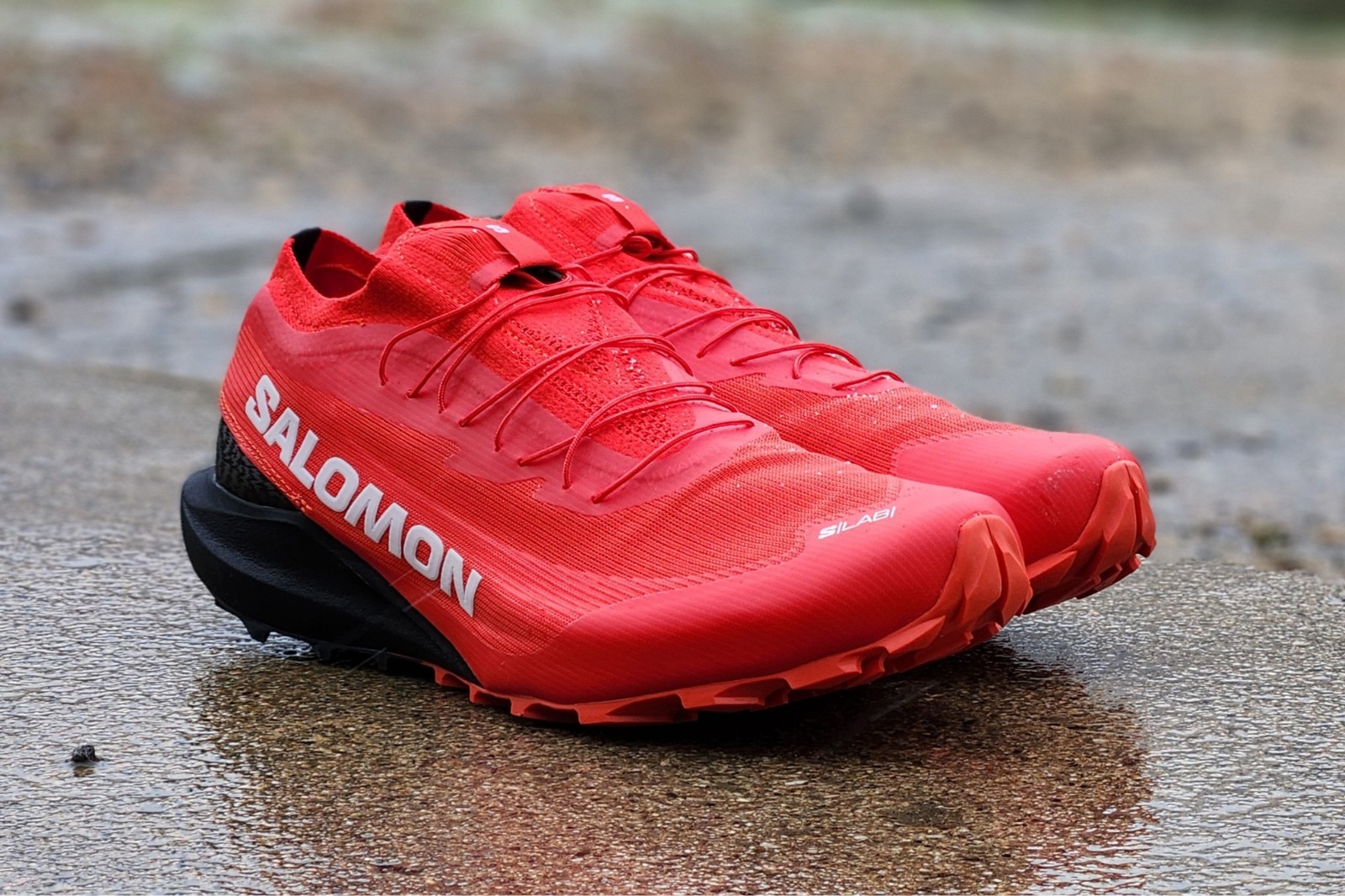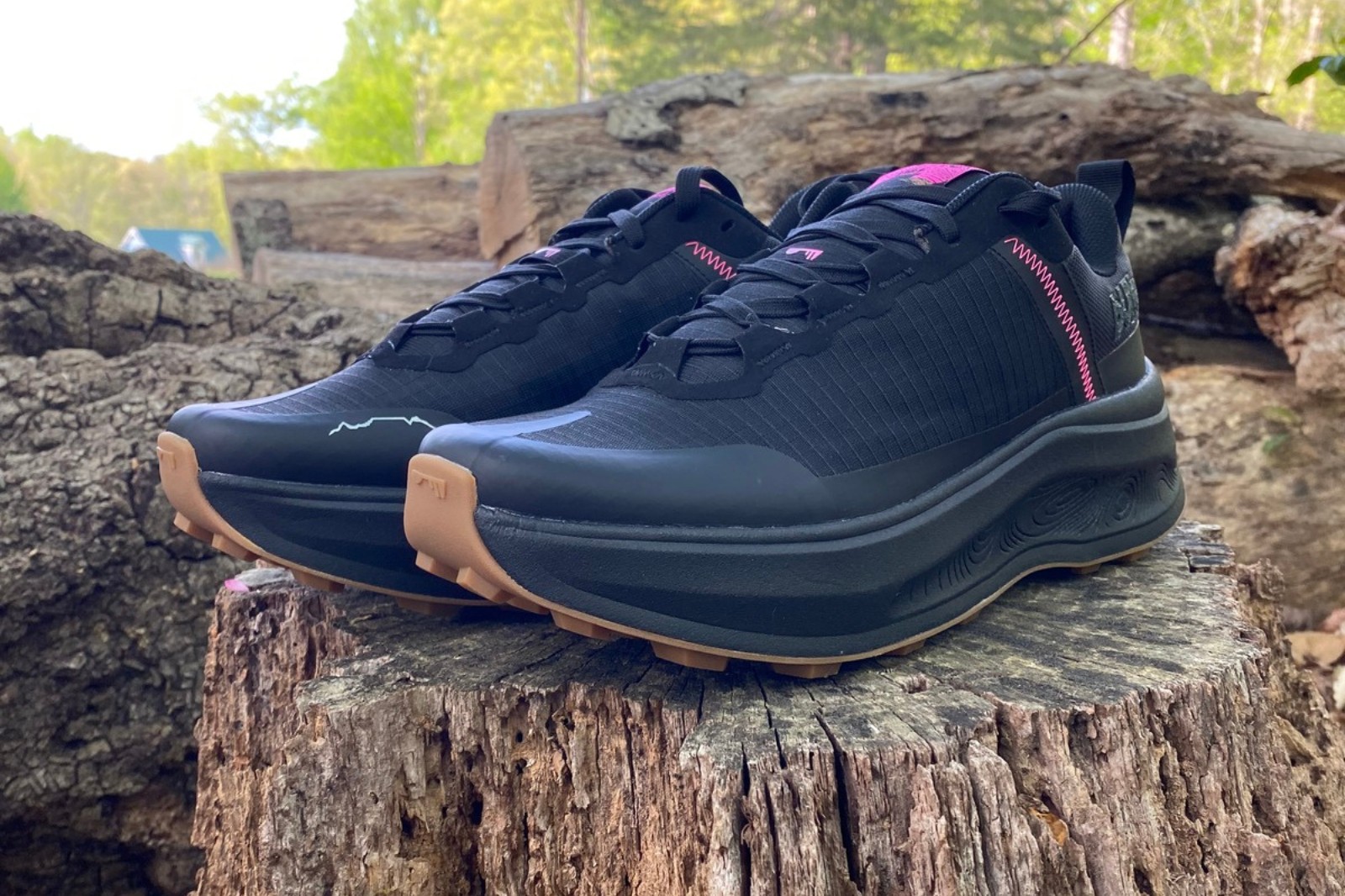

We independently review everything we recommend. When you buy through our links, we may earn a commission.
7.1 oz. (201 g) for a US M9 (Unisex Sizing)
29 mm in heel, 23 mm in forefoot (6 mm drop)
Absolutely zoomin’ down trails
Energy Foam midsole, Profeel Film protection, Matryx upper, All Terrain ContaGrip outsole, Quicklace system
Available now for $199
















TAYLOR: There was a time, not long ago, when I held a couple of local FKTs on popular Rocky Mountain National Park routes. At the time, I felt really good about my efforts. I held those FKTs for a couple of years until COVID shut down the racing scene, and it forced pros out of Boulder into the FKT scene. Let’s just say I found out the difference between “local elite” and world-class professional pretty quickly. Salomon Athlete Andy Wacker politely throttled me on both routes.
My shoe of choice was a pair of Salomon S/Lab Sense 6 SG — a shoe I couldn’t personally afford. Thankfully, a friend who manages a local shop had a vendor sample pair and gifted them to me. Like Thor swearing an oath to Odin, I vowed to use it as it was purposed: for speed. The shoe only came out on certain occasions because I knew I would likely never have a pair of shoes like this again. I know, I know… I’m a spoiled brat.
The S/Lab Sense range of shoes is known as the original pinnacle of trail running. Many of us who think about trail racing shoes think about the iconic black and red lightweight shoes. At their height, they looked good, felt good, and gave the confidence you wanted to have for race day on the trails.
Then, Salomon added another horse to its barn with the S/Lab Pulsar. It took the lessons of the lightweight, highly technical shoes they already had and combined them with modern bouncy foams and rockered midsole shapings. The line was an immediate hit but was noticeably a different experience than the S/Lab Sense. Over the last handful of years, the Pulsar range took over as the preferred race-day shoe, and the Sense line (sadly) faded away.
This is a lot of backstory for me to say that the newest version of Salomon’s race shoe is here, and it reminds me of both the modern and original peak experiences. The Salomon S/Lab Pulsar 3 has already been around for a couple of seasons as we’ve seen Golden Trail Series champions Sophia Laukli and Remi Bonet absolutely crush it, and now it’s on my feet, too.
One thing I noticed during last season’s races is that both athletes chose this shoe for almost all of their races, even on trails that were vastly different in terrain and conditions. That gained intrigue because it showed depth in performance, whereas the S/Lab Puslar 2 series was typically limited to less technical racing, and the S/Lab Sense series came out when nimbleness was needed.
What we know now is that the Salomon S/Lab Pulsar 3 brings the first major change to the series. There’s more foam underfoot, reconfigured outsole, and some different geometries at play. The new flashy specs seem to equal performance because here’s what I gathered:

TAYLOR: Light is fast, and fast is fun. And so the story goes with the Salomon S/Lab Pulsar 3.
A big part of this recipe is combining high-performing ingredients while maintaining a very light profile. Think track spikes or racing flats, just with a modern performance-enhanced twist. Just 7.7 oz for a US M10.5 is pretty wacko. There are just a few trail shoes that can proudly say they come under 9 ounces for sample size, including the previous Salomon S/Lab Pulsar 2, Merrell Skyfire 2, Nnormal Kjerag, and Brooks Catamount Agil.
The cost of being so light is often a lack of protection, but I didn’t get that vibe during my miles in the Salomon S/Lab Pulsar 3. This carried its weight and then some in the protection department. Yes, there was a productive amount of ground feel; however, the 29/23 mm stack and Profeel Film (thin material that acts like a subtle rock guard) helped filter out most of the trail invaders.
With the previous model, I found that the foam quickly bottomed out and lost its snappy shape and any semblance of protection, which is the arc of many modern foams. The Salmon S/Lab Pulsar 3 proved to be quite a bit more resilient and noticeably more protective.
For starters, the whole forefoot is wrapped in the Matryx upper and an adhered overlay. This design acts like a casing to hold the foam’s structure even as it softens a bit. We’ve seen this in the Nike Ultrafly and Saucony Endorphin Trail (remember that tank?!). Even though it’s not as “bouncy” of an experience as before, I do prefer this underfoot sensation for a specific reason.
And that reason is… control. The forefoot creates a dynamic that feels somewhere between the first two S/Lab Pulsar models and the S/Lab Sense models of old. That will give some of you goosebumps, and some of you won’t have a clue what that means.
Something the Pulsar is known for is a pronounced rocker. That doesn’t necessarily change with the S/Lab Pulsar — there’s a smooth, lively, and efficient toe-off from start to finish. Compared to the S/Lab Pulsar 2, this is a slightly firmer snap, even though the rocker itself is less pronounced. This, combined with the exposed bouncy Energy Foam in the heel, is especially helpful on smooth to moderately technical terrain where I could sink into a consistent clip and glide down the trail quickly.
The difference is that now, thanks to the wrapped midsole, the forefoot is more stable and nimble in the Salomon S/Lab Pulsar 3. It can handle the smooth and fairly technical at high speeds, but it finds its sweet spot where there is less polarity. It is an absolute crusher when there is a good mix of terrain.


Woven Matryx uppers are popping up in many high-performing trail shoes lately. The Merrell Long Sky 2 Matryx, Hoka Tecton X 2, and Salomon Genesis have all entered the matrix and don’t plan on looking back. The Salomon S/Lab Pulsar 3 also has a Matryx upper that keeps a consistent fit and is rock solid in the lightweight durability arena. I really like how Salomon combined socklike comfort and next-to-skin fit around the heel collar and tongue. Also, the Quicklace system locks it all down nicely, too.
Overall, the fit is impressively secure because of these ingredients. The slimmer profile that starts from the moderately padded heel collar through the midfoot really helps, too. The S/Lab Pulsar 3 also has the most generous forefoot of any other S/Lab shoe I’ve run in. The volume is more in line with that of the S/Lab Ultra or La Sportiva Prodigio. I’m not saying it’s wide, but it will definitely accommodate the typical foot for shorter, faster racing.
Because Salomon is saying “see you later” to the soft-ground versions of this shoe, they bumped the outsole lug depth up a notch. The layout of multidirectional 4.5 mm All Terrain ContaGrip lugs gave confidence in versatile conditions. Even muddy sections were no issue for this race-day shoe.
Shop The Shoe - Unisex
TAYLOR: One of the odd additions to this line is the more pointed toe, which is reminiscent of the Speedcross series. Of course, the S/Lab Pulsar 3 has a much slimmer profile, so the extra room and pointy toe just feel weird. I’m not sure if the design is purposeful for a little extra toe bump protection or was needed to allow the Matryx upper to fold nicely around the forefoot. Again, it wasn’t an overly bad thing… just weird.
Foot security is a positive, as outlined above, until it’s not. For most terrain, my foot felt securely fastened to the footbed. Cocked, locked, and ready to rock — those side hills, though. When the trail turned sideways, my foot slipped from the footbed almost completely a couple of times. It was wild going from completely fine and cruising to basically kick-flipping my shoe. The fact that it happened a couple of times on the exact same terrain concerned me. Be extremely careful on steep, technical terrain.
I did learn to pull the Quicklace system tighter than I felt necessary from the start of the run to help mitigate some of these issues. I could still run with a good amount of confidence on a variety of terrain. Those tilted trails will always tingle my spider senses, though.
Lastly, even though the S/Lab Pulsar 3 is noticeably more durable than previous versions, this foam is still a fickle one. This shoe will work best on an “at-call” basis. Reserve it for a handful or two of really hard performances. I’m afraid that the magic of the foam will quickly fall away after that.
Shop The Shoe - Unisex
TAYLOR: What’s the verdict? It’s so frickin fun. Whether the trail is fairly dicey or smoother than clarified butter, the S/Lab Pulsar 3 has a lightweight feel and smooth transition to go with the flow. This shoe is absolutely a race day shoe to consider for shorter, faster races or FKT attempts. In my opinion, shorter could mean anything from a VK to a few hours’ worth of running. The Salomon S/Lab Pulsar 3 feels fast and gives confidence. Overall, it is higher performing and more comfortable than the previous models. What more could one ask for from an update?
Side note: I like that Salomon offers this high-level performance without the mention of a plate. This will be my shoe of choice come race day at the Golden Trail Series Broken Arrow 18k.
You can pick up the Salomon S/Lab Pulsar 3 for $199 at Running Warehouse (featuring free 2-day shipping and 90-day returns) using the buttons below.
Shop The Shoe - UnisexHave something to say? Leave a Comment

Taylor Bodin is a trail and ultra runner living in Estes Park, Colo., with his wife and daughters. As the head of the Dirt Division at Believe in the Run, trail running is pretty much the only hobby he can manage right now and loves it. Every so often, he will pop off a race or FKT attempt because competition is pure and the original motivator for him getting into running anyway.
More from Taylor
